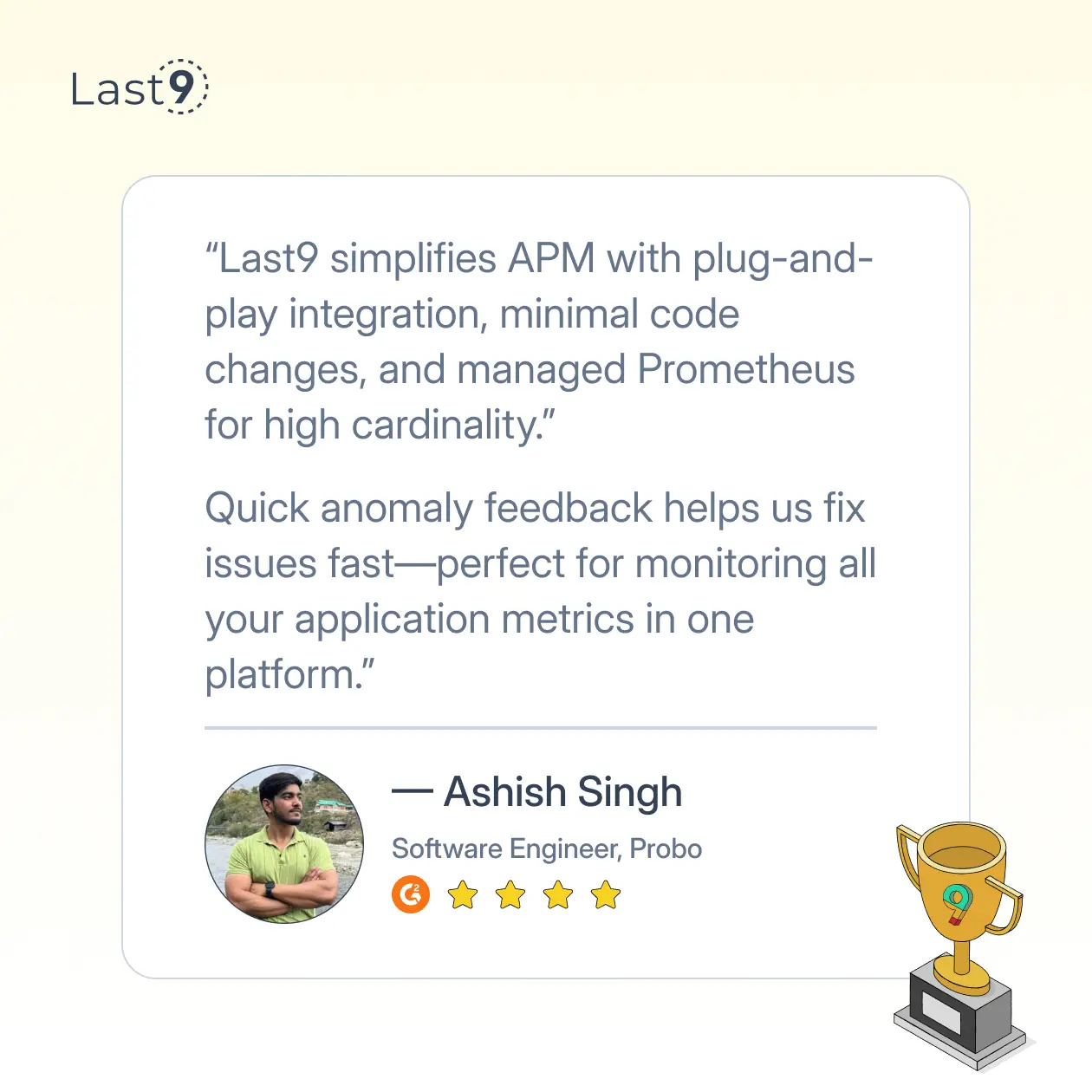Modern software systems are complex, with multiple services interacting across different environments. Understanding how they behave—tracking performance, identifying bottlenecks, and diagnosing failures—requires more than just collecting data.
OpenTelemetry provides a standardized way to gather logs, metrics, and traces, but the real value comes from making that data easy to interpret through visualization.
What is OpenTelemetry?
OpenTelemetry acts as a common framework for collecting telemetry data across different programming languages and infrastructures.
Instead of dealing with multiple tools that use different formats, it allows developers to instrument their applications once and send data to various backends, such as Last9, Prometheus, or others.
For example, in a microservices-based e-commerce application, OpenTelemetry can track a request as it moves through payment processing, inventory management, and checkout. This creates a complete picture of how different services interact, making it easier to identify performance issues or failures.
Why Visualization Matters (With Examples)
Spot Performance Bottlenecks
Imagine a SaaS platform where users report slow load times. A latency heatmap shows that response times spike whenever a specific microservice is called.
Further analysis reveals that a database query in that service is taking longer than expected due to missing indexes. With this insight, the engineering team optimizes the query, reducing load times without unnecessary debugging efforts.
Understand System Architecture
Consider a financial services company running a microservices-based payment system. A service dependency graph reveals that a critical payment processing service is overloaded, causing delays in transaction approvals.
Thus, by redistributing traffic or scaling the service, the team ensures smoother operations without disruptions.
Monitor Real-Time Operations
A large e-commerce site rolls out a new recommendation engine. Within minutes, a live dashboard shows an increase in 5xx errors.
Engineers quickly trace the issue to a misconfigured API call and revert the change before customers experience widespread failures.
Analyze Historical Trends
An online streaming platform notices user drop-offs after initiating video playback. A time-series chart comparing user retention before and after a recent backend update reveals that increased buffering times correlate with higher abandonment rates.
The team rolls back the update and investigates further before reapplying changes.
Step-by-Step Guide for OpenTelemetry Visualization
Visualizing OpenTelemetry data is essential for understanding system health, troubleshooting issues, and optimizing performance.
This section walks through setting up OpenTelemetry visualization using Last9, a telemetry data platform designed for scalable observability.
Step 1: Set Up OpenTelemetry Instrumentation
Before visualizing data, instrument your application to collect telemetry data (logs, metrics, and traces).
Install OpenTelemetry SDK
For Python:
pip install opentelemetry-sdk opentelemetry-exporter-otlpFor Node.js:
npm install @opentelemetry/sdk-node @opentelemetry/exporter-otlp-grpcConfigure Exporters to Send Data to Last9
Modify your application configuration to use OTLP (OpenTelemetry Protocol) for exporting data to Last9.
Python Example:
from opentelemetry.sdk.trace import TracerProvider
from opentelemetry.sdk.trace.export import BatchSpanProcessor
from opentelemetry.exporter.otlp.proto.grpc.trace_exporter import OTLPSpanExporter
tracer = TracerProvider()
exporter = OTLPSpanExporter(endpoint="https://api.last9.io/otlp")
tracer.add_span_processor(BatchSpanProcessor(exporter))Step 2: Send Test Telemetry Data
Verify that your OpenTelemetry setup is working by generating test spans and metrics.
Python Example:
from opentelemetry import trace
tracer = trace.get_tracer(__name__)
with tracer.start_as_current_span("test-span"):
print("Test span recorded")Run your application and confirm that spans appear in Last9.
Step 3: Set Up Last9 for Visualization
- Sign Up for Last9 – Create an account and navigate to the dashboard.
- Create a New Telemetry Project – Configure Last9 to receive OpenTelemetry data via OTLP.
Step 4: Optimize Data for Better Insights
- Use Sampling – Reduce noise by controlling the volume of trace data sent.
- Tag Important Attributes – Ensure telemetry data has consistent tags for easier correlation.
- Set Alerts & Anomaly Detection – Use Last9’s proactive monitoring to detect performance issues early.
Open-Source vs. Commercial Visualization Tools
Choosing between open-source and commercial visualization tools depends on your team’s requirements, infrastructure, and budget. Here’s a breakdown of the key options.
Open-source options
Grafana – A go-to tool for metrics visualization, commonly used with Prometheus for monitoring, Loki for logs, and Jaeger for traces. It’s highly customizable but may require manual setup for OpenTelemetry data.
Kibana – Primarily used for log and event visualization, typically paired with Elasticsearch. It provides powerful search capabilities but lacks built-in tracing support.
Jaeger – Focuses on distributed tracing, helping teams analyze request flows in microservices architectures. However, it doesn’t handle metrics or logs well on its own and often requires additional tools.
Commercial options
Last9 – Built for large-scale reliability engineering, offering native OpenTelemetry support, AI-powered insights, and automated correlation across logs, metrics, and traces. Optimized for handling high-cardinality telemetry data.
Datadog – Provides a full-stack observability solution with OpenTelemetry support. It includes powerful dashboards and anomaly detection but can become expensive as data volume grows.
New Relic – Offers deep visibility into distributed systems, with strong telemetry data correlation and performance monitoring. Pricing is based on data ingestion, which may be a concern for high-traffic applications.

5 Challenges in OpenTelemetry Visualization You Should Know
OpenTelemetry provides extensive observability data, but effectively visualizing this data comes with its own set of challenges.
Below are some common hurdles and strategies to overcome them.
1. High Cardinality and Large Data Volume
OpenTelemetry generates a significant amount of telemetry data, including logs, metrics, and traces. High-cardinality attributes (e.g., user IDs, session IDs) can make visualization tools struggle with performance and usability.
Solution:
- Use aggregation techniques to summarize data without losing key insights.
- Implement dynamic sampling to reduce trace volume while preserving essential details.
- Choose visualization tools designed to handle high-cardinality data efficiently.
2. Correlating Logs, Metrics, and Traces
One of OpenTelemetry’s strengths is its ability to collect different types of telemetry data, but correlating these across multiple dimensions for visualization can be complex.
Solution:
- Ensure consistent tagging across logs, metrics, and traces to improve correlation.
- Use dashboards that allow seamless context switching between different data types (e.g., from an error log to the corresponding trace).
- Adopt tools that automatically link related telemetry signals.
3. Lack of Standardized Dashboards
Many OpenTelemetry implementations do not come with predefined dashboards, requiring manual configuration tailored to specific needs.
Solution:
- Use community-driven OpenTelemetry dashboard templates as a starting point.
- Standardize dashboard configurations across environments for consistency.
- Use pre-built dashboards available in observability platforms to reduce setup time.
4. Latency in Data Processing and Rendering
Real-time monitoring depends on low-latency visualization, but processing and rendering OpenTelemetry data can introduce delays.
Solution:
- Optimize data pipelines to eliminate processing bottlenecks.
- Use in-memory storage or time-series databases optimized for fast retrieval.
- Adjust dashboard refresh intervals to balance real-time accuracy with performance.
5. Complex Querying for Deep Insights
Extracting valuable insights from OpenTelemetry data often requires complex queries, which can be challenging to construct and optimize.
Solution:
- Use query builders or visual query editors to simplify data exploration.
- Implement a well-structured schema for telemetry data to facilitate querying.
- Train teams on effective querying techniques tailored to their observability stack.
How to Choose the Right Visualization Tool for OpenTelemetry
The best tool should help you explore logs, metrics, and traces in one place while keeping up with the scale of your system. Here’s what to look for:
1. Easy Integration—No Extra Headaches
Some tools require tedious setup, custom exporters, or complex configurations just to get OpenTelemetry data flowing.
Ideally, you want a tool that natively supports OpenTelemetry so you can start visualizing data with minimal effort. Less time wrestling with configurations means more time actually using the insights.
2. Unified View of Logs, Metrics, and Traces
Your system health isn’t just about one data type—logs, metrics, and traces all tell different parts of the same story.
A good tool doesn’t just display them separately; it connects the dots, helping you correlate logs with spikes in latency or trace bottlenecks back to the root cause. Without this, troubleshooting becomes a guessing game.
3. Handles Scale Without Slowing You Down
High-cardinality data (think user IDs, request paths, container instances) can quickly overwhelm a poorly optimized tool.
If you’re running at scale, your visualization platform needs to process massive amounts of real-time data without grinding to a halt. Look for tools designed for observability at scale, especially if you deal with dynamic infrastructure like Kubernetes.
4. Smart Alerts—Not Just Pretty Charts
Dashboards are great, but staring at them all day isn’t practical. Your tool should alert you when something’s off, whether it’s a sudden spike in error rates or an unusual traffic pattern.
Better yet, look for platforms with anomaly detection that can catch issues before they escalate, so you’re not always playing catch-up.
5. Flexible Dashboards and Powerful Queries
No two teams need the same visualizations. Whether it’s custom charts, SQL-like queries, or drag-and-drop dashboard builders, flexibility is key.
If a tool forces you into rigid templates or doesn’t let you drill down into details, troubleshooting can become frustrating fast.
Best Practices for OpenTelemetry Visualization
Here are some best practices to get the most value from your telemetry data.
Correlate logs, metrics, and traces
A common mistake is visualizing logs, metrics, and traces in isolation. Instead, create dashboards that link these signals together to provide a complete picture.
Example: When an alert triggers due to high API latency, a well-designed dashboard should allow engineers to drill down from the metric to related traces and logs to diagnose the root cause.
Focus on high-impact metrics
Too many visualizations can create noise, making it hard to spot critical issues. Prioritize key performance indicators that reflect system health and user experience.
Recommended metrics:
- Latency (P50, P90, P99 response times) to identify slow endpoints
- Error rates to highlight failing requests and system failures
- Throughput to track the number of requests handled per second
- Resource utilization (CPU, memory, disk I/O) to detect capacity issues before they impact performance
Use aggregation to handle high-cardinality data
High-cardinality attributes like user IDs and session IDs can overwhelm visualization tools. Use aggregation techniques to balance detail and performance.
Example: Instead of visualizing every individual user request, group requests by status code or region to see broader trends.
Design dashboards for actionability
Dashboards should guide troubleshooting, not just display data. Organize them based on use cases such as performance monitoring, error detection, and capacity planning.
Effective dashboard layout:
- Overview panel for high-level system health (uptime, error rates, latency)
- Service-level breakdown for individual microservices, APIs, or endpoints
- Deep-dive sections to explore specific logs, traces, and dependencies
Implement real-time and historical views
Real-time dashboards help detect incidents, while historical trends support long-term optimizations and capacity planning.
Example: A time-series chart comparing API response times before and after a deployment can show if a recent code change introduced performance regressions.
Set up alerts for anomalies
Visualization is most effective when combined with automated alerting. Set up threshold-based alerts (e.g., error rate above 5%) and anomaly detection for unexpected patterns.
Example: If database query latency spikes at an unusual time, an anomaly detection alert can notify the team before customers are affected.
Optimize for performance
Large datasets and frequent queries can slow down dashboards. Improve performance by:
- Using downsampling for long-term data storage
- Caching frequently accessed queries to reduce load
- Filtering data by time range to avoid excessive rendering
Choose the right visualization type
Different types of data require different visual representations.
- Request latency: Heatmaps, line charts
- Error rates: Bar charts, pie charts
- Service dependencies: Service maps, flow diagrams
- Logs: Table views with search filters
- Historical trends: Time-series graphs
Regularly review and refine dashboards
As applications evolve, dashboards should be updated to stay relevant. Periodically review visualizations to:
- Remove outdated or irrelevant panels
- Add new KPIs based on recent system changes
- Optimize queries to improve dashboard responsiveness
Use a scalable observability platform
The right platform simplifies the visualization and correlation of OpenTelemetry data. Solutions like Last9 provide native support for high-cardinality telemetry data, AI-driven insights, and pre-built dashboards to accelerate troubleshooting.
FAQs
1. How is OpenTelemetry different from visualization tools?
OpenTelemetry is a framework for collecting telemetry data (logs, metrics, and traces), but it does not provide built-in visualization. Instead, it exports data to observability platforms like Last9, Grafana, or Datadog, which handle visualization, storage, and analysis.
2. Can OpenTelemetry visualize data in real-time?
OpenTelemetry itself does not include a visualization layer, but it exports real-time data to observability tools. Platforms like Last9 process and display this data instantly, allowing teams to monitor live system behavior, track spikes in latency, and detect anomalies as they happen.
3. Does OpenTelemetry support multiple programming languages?
Yes. OpenTelemetry is designed for multi-language support and provides SDKs for popular languages, including:
- Go
- Python
- Java
- Node.js
- C++
- .NET
- Ruby
This flexibility allows teams to standardize telemetry collection across a diverse tech stack.
4. What types of data can OpenTelemetry collect?
OpenTelemetry collects three main types of observability data:
- Traces – Captures the flow of requests across services.
- Metrics – Measures system performance (e.g., latency, error rates, CPU usage).
- Logs – Records events and debugging information.
A strong visualization tool can correlate all three data types in a single view for better troubleshooting.
5. How do I choose a visualization tool for OpenTelemetry?
When selecting a visualization tool, consider factors like:
- Native OpenTelemetry support – Reduces integration overhead.
- Scalability – Handles large datasets efficiently.
- Multi-signal correlation – Links logs, metrics, and traces together.
- Customization – Allows tailored dashboards and queries.
Example: Last9 is a strong choice for large-scale observability, providing built-in OpenTelemetry support, AI-driven insights, and automated anomaly detection.
6. Can OpenTelemetry work with cloud-native applications?
Yes, OpenTelemetry is built for cloud-native environments and integrates seamlessly with Kubernetes, serverless architectures, and containerized applications.
For example, you can deploy OpenTelemetry collectors in a Kubernetes cluster to capture pod-level metrics, logs, and traces, and then visualize them in Last9.
7. What is the best way to visualize OpenTelemetry traces?
Trace data is best visualized using:
- Service dependency graphs – Show how services interact.
- Flame graphs – Highlights where requests spend the most time.
- Gantt charts – Displays request lifecycles across different services.
Tools like Last9 and Jaeger provide native support for tracing visualization.
8. Can I use OpenTelemetry with existing monitoring tools?
Yes. OpenTelemetry is vendor-agnostic and can export data to various monitoring platforms, including:
- Prometheus (for metrics)
- Jaeger (for traces)
- Elasticsearch/Kibana (for logs)
- Last9 (for full-stack observability)
This flexibility allows teams to adopt OpenTelemetry without replacing their existing monitoring stack.
9. How do I reduce noise in OpenTelemetry dashboards?
To avoid overwhelming dashboards with excessive data:
- Use sampling to limit the number of traces collected.
- Aggregate metrics instead of displaying raw values.
- Filter logs to show only warnings and errors instead of all log levels.
- Create role-specific dashboards (e.g., separate views for DevOps, SREs, and developers).



